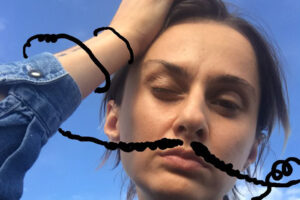November 22, 2022
By Valentina Iancu
Motherhood and Nature in Times of Mourning a Changing Planet
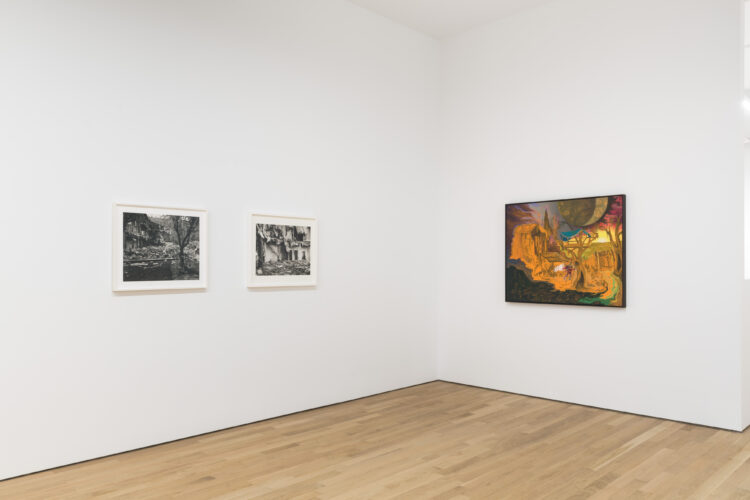
I’m Not Your Mother (2022) installation view
How do we speak about nature after centuries of repeating the ancient dichotomic understanding of man as outside, above and entitled to destroy it? How do we look at nature in the present apocalyptic times of an accelerated ecocide? The most recent exhibition opened at P.P.O.W. gallery in New York city, I’m Not Your Mother, delves into the nature-culture inquiries, from an ecofeminist perspective, connecting witty and wise works by Grace Carney, Jasper Francis Cropsey, LaToya Ruby Frazier, Jacci Den Hartog, Brook Hsu, Hortensia Mi Kafchin, Daniel Correa Mejía, Nohemí Pérez, Carolee Schneemann, Mira Schor, TARWUK and Robin F. Williams.
The exhibition I’m Not Your Mother navigates landscape narratives though means of painting, sculpture and photography, interconnecting works that “reject misogynistic and romanticized depictions of nature and grapple honestly with the realities of our natural world today”[1] Motherhood and nature symbolic bodies are narrated inside evolutionary hierarchies as opposed to men, lower and lesser, unpredictable, unstable and wild, subjected domination, subjugation, control, administration, exploitation. The mythologies derived from the nurturing qualities of the feminine and nature, rooted in a teleological understanding of the biological, co-create a layered and complex set of arguments that nowadays justify the domination of both women and nature in neoliberal societies. In overlapping feminism and environmentalism, the exhibition curator, Eden Deering, makes space for questioning “how we define motherhood and its damaging consequences for bodies both feminized and ecological.”[2] Build non-linearly, circling contemporary feminist perspectives, from La Toya Ruby Frazier’s apocalyptic urban landscapes to Hortensia Mi Kafchin’s surreal dreamscapes or Robin F. Williams’ explorations of feminine corporeal anxieties cultivated by mass culture, the curatorial narrative travels through the emotional nature of the iconic feminists Carolee Schneemann and Mira Schor, back to the typical the 19th century colonial landscape of Jasper Francis Cropsey.
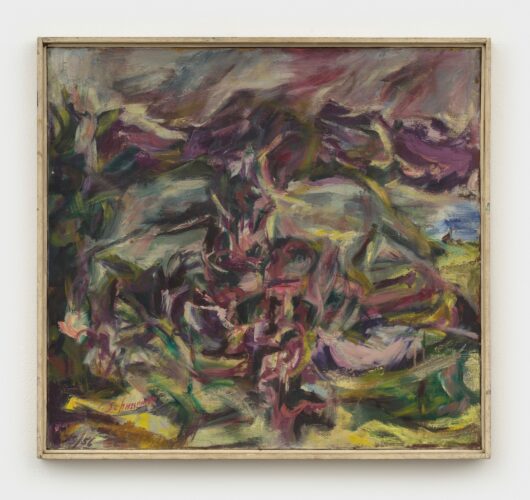
Carolee Schneemann – Secret Garden, 1956
Carolee Schneemann’s Secret Garden, from her beginnings as a landscape artist experimenting with the methods of the rising abstract expressionism, is a vivid gestural painting referring to the chaotic force of nature, unstable and essentially feminine. Unpredictable, in continuous transformation, the feminine and the ecological symbolic bodies are imagined with similar languages, in a complex poetics of difference useful for the patriarchal capitalist oppressive politics. While men are attributed with analytic and critical thought, women are seen as emotional beings, wild, close to nature, incapable of self-agency, therefore without autonomy. The wild “contemporary culture is a fast-evaporating concept, a terrain that barely exists, a category of life lost to knowledge and a disintegrating future of potential.”[3] In Wild Things. The Disorder of Desire, Halberstam defines “the wild” rhizomatically, informed by feminist and queer theory, decolonial critique or critical race studies, amplifying Schneemann’s generational revolutionary perspectives on nature with broader contemporary understandings:
“Wildness names simultaneously a chaotic force of nature, the outside of categorization, unrestrained forms of embodiment, the refusal to submit to social regulation, loss of control, the unpredictable. This sequence suggests a romantic wild, a space of potential, an undoing that beckons and seduces. But obviously, the wild has also served to name the orders of being that colonial authority comes to tame: the others to a disastrous discourse of civilization, the racialized orientation to order the reifying operations of racial discourse (wild ‘things’). For this reason, to work with the wild is also to risk and reengaging these meanings.” (Jack Halbertam)
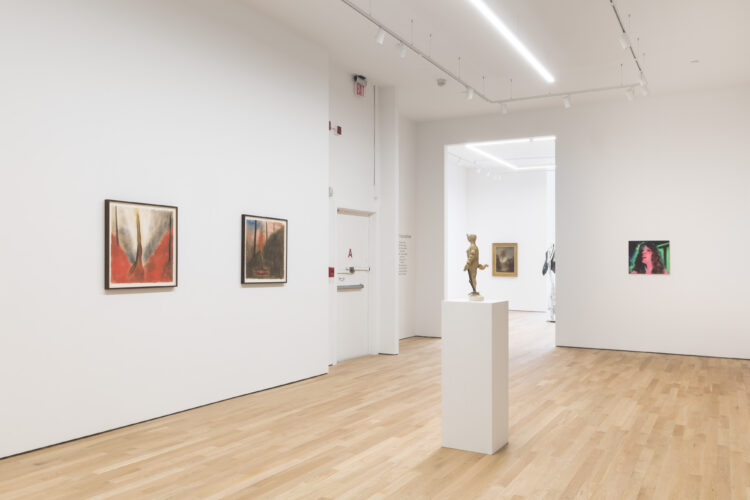
I’m Not Your Mother (2022) installation view
In the US, in the 19th century, realist plein-air landscapes were used for settler colonial propaganda. The Hudson River School of panting, an echo of the French Barbizon movement, produced a series of pastoral landscapes, domesticating the wild into romantic scenarios for consumption, such as the Jasper Francis Cropsey’s Head of a Lake, depicted in 1877. The Eurocentric ideas of landscape regarding nature are deeply rooted in the imagination of nature as belonging to the human. Considering the total absence of civil rights for women until the 20th century, the question of ownership is deeply gendered. Nature as a resource for humans, deprived from its lively organismic matrix qualities, was imagined through manipulating the fear of the chaotic and unpredictable forces of the wild, in similar ways, feminine bodies were culturally constituted, normed and regulated. Masculinized agency narrates nature as land, a future resource to be capitalized in the production of the nation together with the nurturing qualities of women. Before becoming a choice or an option, motherhood was a national duty. Giving birth, nurturing and caring for others are the feminine qualities and obligations exploited in patriarchal societies and extended to the understanding of nature as a resource. This mechanistic view is directly connected to the major political, economic, social, and ecological changes of the modern times. Carolee Schneemann’s letter to Ingrid Christie, reflecting on mother, mothering, motherhood that inspired the exhibition title stages a feminist tension on these heavy constructions placed on woman’s shoulders. While affirming a resistance to the “accolade of mother”, Schneemann shows herself in an act of non-human care, feeding her cat companion Nina. While criticizing the instrumentalization of the biological, she gives animals the rights to be taken care of and loved or just “making kin”, in Harraway ecofeminist terms. Exhibiting Jasper Francis Cropsey’s landscape near several critical approaches emphasize how the male gaze is directed, what it affirms, what it erases, which power games does it play. According to Halberstam’s study, the romantic wild is a political way of seeing, deeply rooted in misogynist, racist and homophobic thinking. The violent historical treatment designed for suppressing the chaotic force of the wild, applies both to certain categories of humans and to nature.
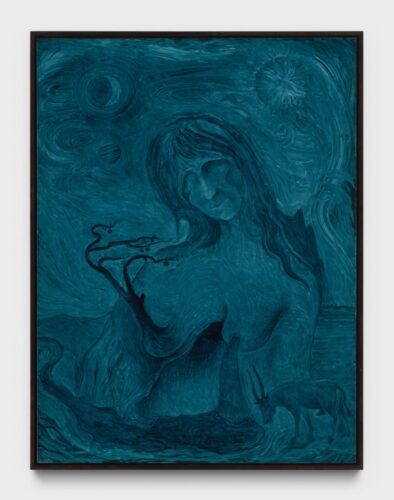
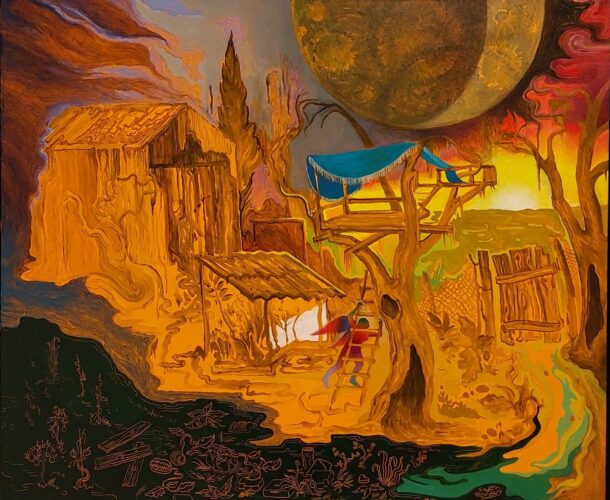
The aquatic movement of waterfalls captured by Jacci den Hartog in her watery sculptures, the sensual telluric landscapes of Mira Schor, the dreamy surreal treehouse from Hortensia Mi Kafchin’s childhood, the zoomorphic body with prosthesis of the artistic duo TARWUK (Bruno Pogacnik Tremow & Ivana Vukšic) reclaim a more holistic perspective on nature, with deep roots in its healing, esoteric and alchemical powers. Challenging and empowering critical thoughts regarding how feminine and natural bodies are dominated through fetishization are evident in Hortensia Mi Kafchin’s and Robin F. Williams’ paintings. Williams researches femicide in horror movies, inviting the viewer to reflect upon the pleasure we take from consuming violence against women (and nature). Hortensia Mi Kafchin reworks the patriarchal mythologies of “mother nature”, queering the normative representation of a beautiful female wearing symbols of fecundity and fertility. The expected object of male desire is painted as a solemn old silhouette in a stormy landscape, suggesting a memento mori, Mortality or Death rather than celebrating Life. Fluid lines traced in watery turquoise with performative, alert gestures, hurried by the drying paint, reveal an uncanny figure, a ghostly apparition recalling Edvard Munch’s and other lesser-known Scandinavian artists’ dramatic depictions of sickness. Mother nature is mourning. The current ecological crisis, the environmental losses and anticipated future destruction transform our era into one of grief. LaToya Ruby Frazier’s photographs from The Grey Area Series (2011) indicate how the idyllic Jasper Francis Cropsey landscape decayed over time after occupation. Her work is investigating how the American landscape is racialized, reminding that racism and ecocide as deeply connected. Who has access to clean nature? Who lives in apocalyptic landscapes, highly affected by pollution, massive deforestation, species extinction, extractions, climate change or simply in the middle of human garbage? The high decay of nature often indicates to the precarious, bare lives of racialized bodies.
How do we look at nature in the present apocalyptic times of an accelerated ecocide? Environmental grief is a way of visualizing an ecofeminist necropolitics oriented to acknowledging histories for unlearning behaviors and inspiring change. The most recent exhibition opened at P.P.O.W. gallery in New York city, I’m Not Your Mother, delves into the nature-culture inquiries, continuing the almost 40 years of socially engaged programs devoted to feminist, queer and other political forms of art. I’m Not Your Mother offers tools for rethinking nature, tracing some threads that have been used to imagine the conflation of women and nature manipulated to the devaluation, exploitation, and degradation of both, entangling works by Grace Carney, Jasper Francis Cropsey, LaToya Ruby Frazier, Jacci Den Hartog, Brook Hsu, Hortensia Mi Kafchin, Daniel Correa Mejía, Nohemí Pérez, Carolee Schneemann, Mira Schor, TARWUK and Robin F. Williams.
Special thanks to Zina Gallery.
[1] Eden Deering – “I’m not your mother” curatorial text
[2] Ibidem
[3] Jack Halbertam “Wild Things. The Disorder of Desire”, Duke University Press, 2022, p 147
POSTED BY
Valentina Iancu
Valentina Iancu (b. 1985) is a writer with studies in art history and image theory. Her practice is hybrid, research-based, divided between editorial, educational, curatorial or management activities ...



